Effect of Intra-Ply Hybrid Patches and Hydrothermal Aging on Local Bending Response of Repaired GFRP Composite Laminates
Abstract
1. Introduction
2. Experimental Procedure
2.1. Materials and Fabrication
2.2. Repair Technique
2.3. Preparation of Water Resistant Repair Specimens
2.4. Environmental Aging Studies
2.5. Quasi-Static Indentation Test with AE Monitoring
3. Results and Discussions
3.1. Effect of Hybridization and Fiber Volume Fraction
3.2. Effect of Hydrothermal Aging
3.2.1. Moisture Uptake Behavior
3.2.2. Effect of Moisture Absorption on Quasi-Static Indentation Behavior
3.2.3. Effect of Moisture Absorption on AE Behavior
4. Conclusions
- The 50G50K specimens are the only repaired specimens that exhibited a higher indentation response (in terms of ultimate load, stiffness and permanent displacement) than the virgin ones;
- In the 50G50K, unlike virgin, 100G, and 75G25K, the Kevlar fibers restricted penetration and prevented fiber breakage. In the same way, unlike 100K and 25G75K, the glass fibers restricted delamination, bulging and elongation;
- At all immersion temperatures, moisture absorption of Type R was the highest, while the Type C exhibited the lowest. The specimens protected using particulate fibers (Type P) exhibited a response between Types R and C specimens. In all the specimens, the increase of immersion temperature reduced the duration required for attaining the saturation level in weight gain;
- At ambient and elevated immersion temperatures, the retention of indentation properties for various specimens were graded from the lower to the higher order as: Type R < Type P < Type C. For every temperature increment, the indentation performance of different specimens was reduced. Specimens aged in seawater at an elevated temperature (70 °C) recorded the lowest ultimate load and stiffness.
Author Contributions
Funding
Conflicts of Interest
References
- İçten, B.M.; Karakuzu, R. Progressive failure analysis of pin-loaded carbon–epoxy woven composite plates. Compos. Sci. Technol. 2002, 62, 1259–1271. [Google Scholar] [CrossRef]
- Bhatia, G.S.; Andrew, J.J.; Balaganesan, G.; Arockiarajan, A. The role of patch-parent configurations on the tensile response of patch repaired carbon/epoxy laminates. Polym. Test. 2018, 70, 413–425. [Google Scholar] [CrossRef]
- Bhatia, G.S.; Andrew, J.J.; Arockiarajan, A. Experimental investigation on compressive behaviour of different patch–parent layup configurations for repaired carbon/epoxy composites. J. Compos. Mater. 2019, 53, 3269–3279. [Google Scholar] [CrossRef]
- Balcı, O.; Çoban, O.; Bora, M.Ö.; Akagündüz, E.; Yalçin, E.B. Experimental investigation of single and repeated impacts for repaired honeycomb sandwich structures. Mater. Sci. Eng. 2017, 682, 23–30. [Google Scholar] [CrossRef]
- Liu, X.; Wang, G. Progressive failure analysis of bonded composite repairs. Compos. Struct. 2007, 81, 331–340. [Google Scholar] [CrossRef]
- Her, S.-C.; Chao, M. Adhesively Bonded Patch Repair of Composite Laminates. J. Adhes. Sci. Technol. 2011, 25, 2569–2585. [Google Scholar] [CrossRef]
- Cheng, P.; Gong, X.-J.; Aivazzadeh, S.; Xiao, X. Experimental observation of tensile behavior of patch repaired composites. Polym. Test. 2014, 34, 146–154. [Google Scholar] [CrossRef]
- Kashfuddoja, M.; Ramji, M. Whole-field strain analysis and damage assessment of adhesively bonded patch repair of CFRP laminates using 3D-DIC and FEA. Compos. B Eng. 2013, 53, 46–61. [Google Scholar] [CrossRef]
- Cheng, P.; Gong, X.-J.; Hearn, D.; Aivazzadeh, S. Tensile behaviour of patch-repaired CFRP laminates. Compos. Struct. 2011, 93, 582–589. [Google Scholar] [CrossRef]
- Soutis, C.; Duan, D.; Goutas, P. Compressive behaviour of CFRP laminates repaired with adhesively bonded external patches. Compos. Struct. 1999, 45, 289–301. [Google Scholar] [CrossRef]
- Sarasini, F.; Tirillò, J.; Ferrante, L.; Valente, M.; Valente, T.; Lampani, L.; Gaudenzi, P.; Cioffi, S.; Iannace, S.; Sorrentino, L. Drop-weight impact behaviour of woven hybrid basalt–carbon/epoxy composites. Compos. B Eng. 2014, 59, 204–220. [Google Scholar] [CrossRef]
- Short, D.; Summerscales, J. Hybrids—A review: Part 2. Physical properties. Composites 1980, 11, 33–38. [Google Scholar] [CrossRef]
- Salehi-Khojin, A.; Bashirzadeh, R.; Mahinfalah, M.; Nakhaei-Jazar, R. The role of temperature on impact properties of Kevlar/fiberglass composite laminates. Compos. B Eng. 2006, 37, 593–602. [Google Scholar] [CrossRef]
- Katnam, K.B.; Da Silva, L.F.M.; Young, T.M. Bonded repair of composite aircraft structures: A review of scientific challenges and opportunities. Prog. Aerosp. Sci. 2013, 61, 26–42. [Google Scholar] [CrossRef]
- Jefferson Andrew, J.; Srinivasan, S.M.; Arockiarajan, A. The role of adhesively bonded super hybrid external patches on the impact and post-impact response of repaired glass/epoxy composite laminates. Compos. Struct. 2018, 184, 848–859. [Google Scholar] [CrossRef]
- Dhakal, H.N.; Zhang, Z.Y.; Richardson, M.O.W. Effect of water absorption on the mechanical properties of hemp fibre reinforced unsaturated polyester composites. Compos. Sci. Technol. 2007, 67, 1674–1683. [Google Scholar] [CrossRef]
- Badawy, A.A.M. Impact behavior of glass fibers reinforced composite laminates at different temperatures. Ain Shams Eng. J. 2012, 3, 105–111. [Google Scholar] [CrossRef]
- Verma, L.; Sivakumar, S.M.; Andrew, J.J.; Balaganesan, G.; Arockirajan, A.; Vedantam, S. Compression after ballistic impact response of pseudoelastic shape memory alloy embedded hybrid unsymmetrical patch repaired glass-fiber reinforced polymer composites. J. Compos. Mater. 2019, 53, 4225–4247. [Google Scholar] [CrossRef]
- Sreekala, M.S.; Kumaran, M.G.; Thomas, S. Water sorption in oil palm fiber reinforced phenol formaldehyde composites. Compos. A Appl. Sci. Manuf. 2002, 33, 763–777. [Google Scholar] [CrossRef]
- Andrew, J.J.; Srinivasan, S.M.; Arockiarajan, A. Influence of patch lay-up configuration and hybridization on low velocity impact and post-impact tensile response of repaired glass fiber reinforced plastic composites. J. Compos. Mater. 2019, 53, 3–17. [Google Scholar] [CrossRef]
- Andrew, J.J.; Srinivasan, S.M.; Arockiarajan, A.; Dhakal, H.N. Parameters influencing the impact response of fiber-reinforced polymer matrix composite materials: A critical review. Compos. Struct. 2019, 224. [Google Scholar] [CrossRef]
- Dhakal, H.N.; Zhang, Z.Y.; Guthrie, R.; MacMullen, J.; Bennett, N. Development of flax/carbon fibre hybrid composites for enhanced properties. Carbohydr. Polym. 2013, 96, 1–8. [Google Scholar] [CrossRef] [PubMed]
- Errajhi, O.A.Z.; Osborne, J.R.F.; Richardson, M.O.W.; Dhakal, H. Water absorption characteristics of aluminised E-glass fibre reinforced unsaturated polyester composites. Compos. Struct. 2005, 71, 333–336. [Google Scholar] [CrossRef]
- Zhou, J.; Lucas, J.P. The effects of a water environment on anomalous absorption behavior in graphite/epoxy composites. Compos. Sci. Technol. 1995, 53, 57–64. [Google Scholar] [CrossRef]
- Espert, A.; Vilaplana, F.; Karlsson, S. Comparison of water absorption in natural cellulosic fibres from wood and one-year crops in polypropylene composites and its influence on their mechanical properties. Compos. A Appl. Sci. Manuf. 2004, 35, 1267–1276. [Google Scholar] [CrossRef]
- Scida, D.; Assarar, M.; Poilâne, C.; Rezak, A. Influence of hygrothermal ageing on the damage mechanisms of flax-fibre reinforced epoxy composite. Compos. B Eng. 2013, 48, 51–58. [Google Scholar] [CrossRef]
- Bhoominathan, R.; Arumugam, V.; Ashok, T.; Jefferson, A.J. Residual strength estimation of CFRP laminates subjected to impact at different velocities and temperatures. Polym. Compos. 2015, 38. [Google Scholar] [CrossRef]
- Daramola, O. Effect of Chemical Treatment on the Mechanical Properties of Sisal Fibre Reinforced Polyester Composites. Leonardo Electron. J. Pract. Technol. 2014, 24, 1–12. [Google Scholar]
- Mwaikambo, L.; Ansell, M. Chemical modification of hemp, sisal, jute, and kapok fibers by alkalization. J. Appl. Polym. Sci. 2002, 84, 2222–2234. [Google Scholar] [CrossRef]
- Mishra, S.; Mohanty, A.K.; Drzal, L.T.; Misra, M.; Parija, S.; Nayak, S.K.; Tripathy, S.S. Environmental effects on the degradation behaviour of sisal fibre reinforced polypropylene composites. Compos. Sci. Technol. 2002, 62, 1357–1372. [Google Scholar]
- Thwe, M.; Liao, K. Effects of environmental aging on the mechanical properties of bamboo–glass fiber reinforced polymer matrix hybrid composites. Compos. A-Appl. Sci. Manuf. 2002, 33, 43–52. [Google Scholar] [CrossRef]
- Mishra, S.; Mohanty, A.K.; Drzal, L.T.; Misra, M.; Parija, S.; Nayak, S.K.; Tripathy, S.S. Studies on mechanical performance of biofibre/glass reinforced polyester hybrid composites. Compos. Sci. Technol. 2003, 63, 1377–1385. [Google Scholar]
- Jarukumjorn, K.; Suppakarn, N. Effect of glass fiber hybridization on properties of sisal fiber–polypropylene composites. Compos. B Eng. 2009, 40, 623–627. [Google Scholar] [CrossRef]
- Pothan, L.A.; Thomas, S. Effect of hybridization and chemical modification on the water-absorption behavior of banana fiber–reinforced polyester composites. J. Appl. Polym. Sci. 2004, 91, 3856–3865. [Google Scholar] [CrossRef]
- Jefferson Andrew, J.; Arumugam, V.; Ramesh, C.; Poorani, S.; Santulli, C. Quasi- static indentation properties of damaged glass/epoxy composite laminates repaired by the application of intra-ply hybrid patches. Polym. Test. 2017, 61, 132–145. [Google Scholar] [CrossRef]
- Kim, S.-W.; Cha, M.-C.; Lee, I.; Kim, E.-H.; Kwon, I.-B.; Hwang, T.-K. Damage evaluation and strain monitoring of composite plates using metal-coated FBG sensors under quasi-static indentation. Compos. B Eng. 2014, 66, 36–45. [Google Scholar] [CrossRef]
- Albouy, W.; Vieille, B. Determination of the damage threshold in woven-ply thermoplastic laminates at T > Tg: Acoustic emission and microscopic damage analysis. Compos. B Eng. 2014, 64, 138–146. [Google Scholar] [CrossRef]
- De Rosa, I.; Santulli, C.; Sarasini, F. Characterization of indentation damage on carbon/epoxy laminates by means of acoustic emission and IR thermography. E-J. Nondestruct. Test. 2009, 2009–05, ID:14271378. [Google Scholar]
- Jefferson Andrew, J.; Arumugam, V. Effect of patch hybridization on the compression behavior of patch repaired glass/epoxy composite laminates using acoustic emission monitoring. Polym. Compos. 2018, 39, 1922–1935. [Google Scholar] [CrossRef]
- Jefferson Andrew, J.; Arumugam, V. Effect of patch hybridization on the tensile behavior of patch repaired glass/epoxy composite laminates using acoustic emission monitoring. Int. J. Adhes. Adhes. 2017, 74, 155–166. [Google Scholar] [CrossRef]
- Andrew, J.J.; Arumugam, V.; Bull, D.J.; Dhakal, H.N. Residual strength and damage characterization of repaired glass/epoxy composite laminates using A.E. and D.I.C. Compos. Struct. 2016, 152, 124–139. [Google Scholar] [CrossRef]
- Jefferson Andrew, J.; Arumugam, V.; Santulli, C. Effect of post-cure temperature and different reinforcements in adhesive bonded repair for damaged glass/epoxy composites under multiple quasi-static indentation loading. Compos. Struct. 2016, 143, 63–74. [Google Scholar] [CrossRef]
- Jefferson Andrew, J.; Arumugam, V.; Saravanakumar, K.; Dhakal, H.N.; Santulli, C. Compression after impact strength of repaired GFRP composite laminates under repeated impact loading. Compos. Struct. 2015, 133, 911–920. [Google Scholar] [CrossRef]
- Akil, H.M.; Cheng, L.W.; Mohd Ishak, Z.A.; Abu Bakar, A.; Abd Rahman, M.A. Water absorption study on pultruded jute fibre reinforced unsaturated polyester composites. Compos. Sci. Technol. 2009, 69, 1942–1948. [Google Scholar] [CrossRef]
- Rao, R.; Balasubramanian, N.; Chanda, M. Moisture absorption phenomenon in permeable fiber polymer composites. J. Appl. Polym. Sci. 2003, 26, 4069–4079. [Google Scholar] [CrossRef]
- Vilay, V.; Mariatti, M.; Mat Taib, R.; Todo, M. Effect of fiber surface treatment and fiber loading on the properties of bagasse fiber–reinforced unsaturated polyester composites. Compos. Sci. Technol. 2008, 68, 631–638. [Google Scholar] [CrossRef]
- Adhikary, K.B.; Pang, S.; Staiger, P.M. Long-term moisture absorption and thickness swelling behaviour of recycled thermoplastics reinforced with Pinus radiata sawdust. Chem. Eng. J. 2008, 142, 190–198. [Google Scholar] [CrossRef]
- Sen, I.; Aral, A.; Seki, Y.; Sarikanat, M.; Sever, K. Variations of mechanical properties of jute/polyester composite aged in various media. J. Compos. Mater. 2012, 46, 2219–2225. [Google Scholar] [CrossRef]
- Panthapulakkal, S.; Sain, M. Studies on the Water Absorption Properties of Short Hemp—Glass Fiber Hybrid Polypropylene Composites. J. Compos. Mater. 2007, 41, 1871–1883. [Google Scholar] [CrossRef]
- Andrew, J.J.; Arumugam, V.; Ramesh, C. Acoustic emission based monitoring of cut-out geometry effects in carbon/epoxy laminates under uni-axial compression. Int. J. Veh. Struct. Syst. 2014, 6. [Google Scholar] [CrossRef]
- Jefferson, A.; Arumugam, V.; Santulli, C.; Jennifers, A.; Poorani, M. Failure modes of GFRP after multiple impacts determined by acoustic emission and digital image correlation. J. Eng. Technol. 2015, 6, 29–51. [Google Scholar]
- Andrew, J.; Ramesh, C. Residual Strength and Damage Characterization of Unidirectional Glass–Basalt Hybrid/Epoxy CAI Laminates. Arab. J. Sci. Eng. 2015, 40, 1695–1705. [Google Scholar] [CrossRef]
- Andrew, J.J.; Arumugam, V.; Ramesh, C. Acoustic emission characterization of local bending behavior for adhesively bonded hybrid external patch repaired glass/epoxy composite laminates. Struct. Health Monit. 2019, 18, 739–756. [Google Scholar] [CrossRef]
- Schmitz, G.K.; Metcalfe, A.G. Stress Corrosion of E-Glass Fibers. Ind. Eng. Chem. Prod. Res. Dev. 1966, 5, 1–8. [Google Scholar] [CrossRef]
Sample Availability: Samples of the compounds are not available from the authors. |
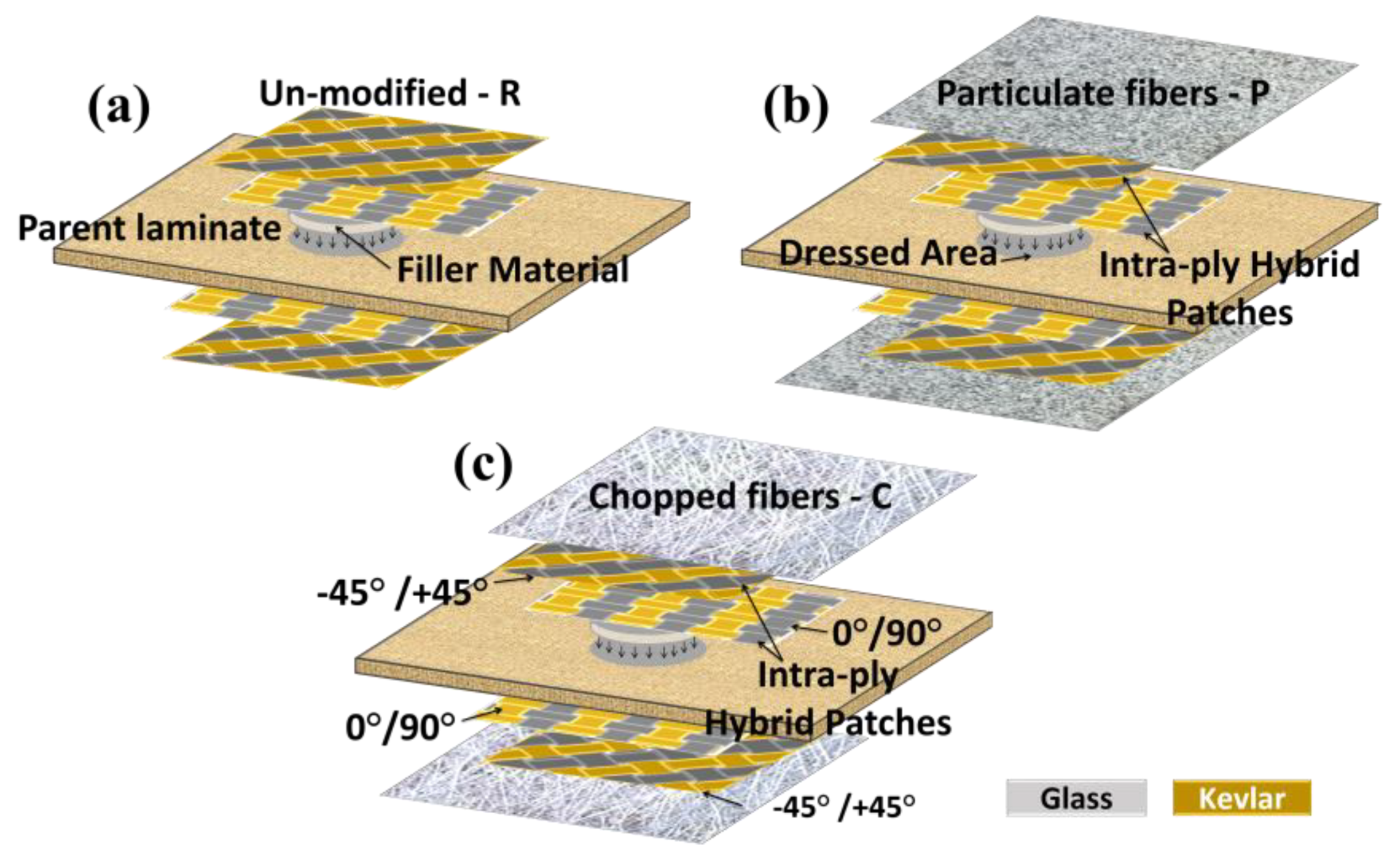
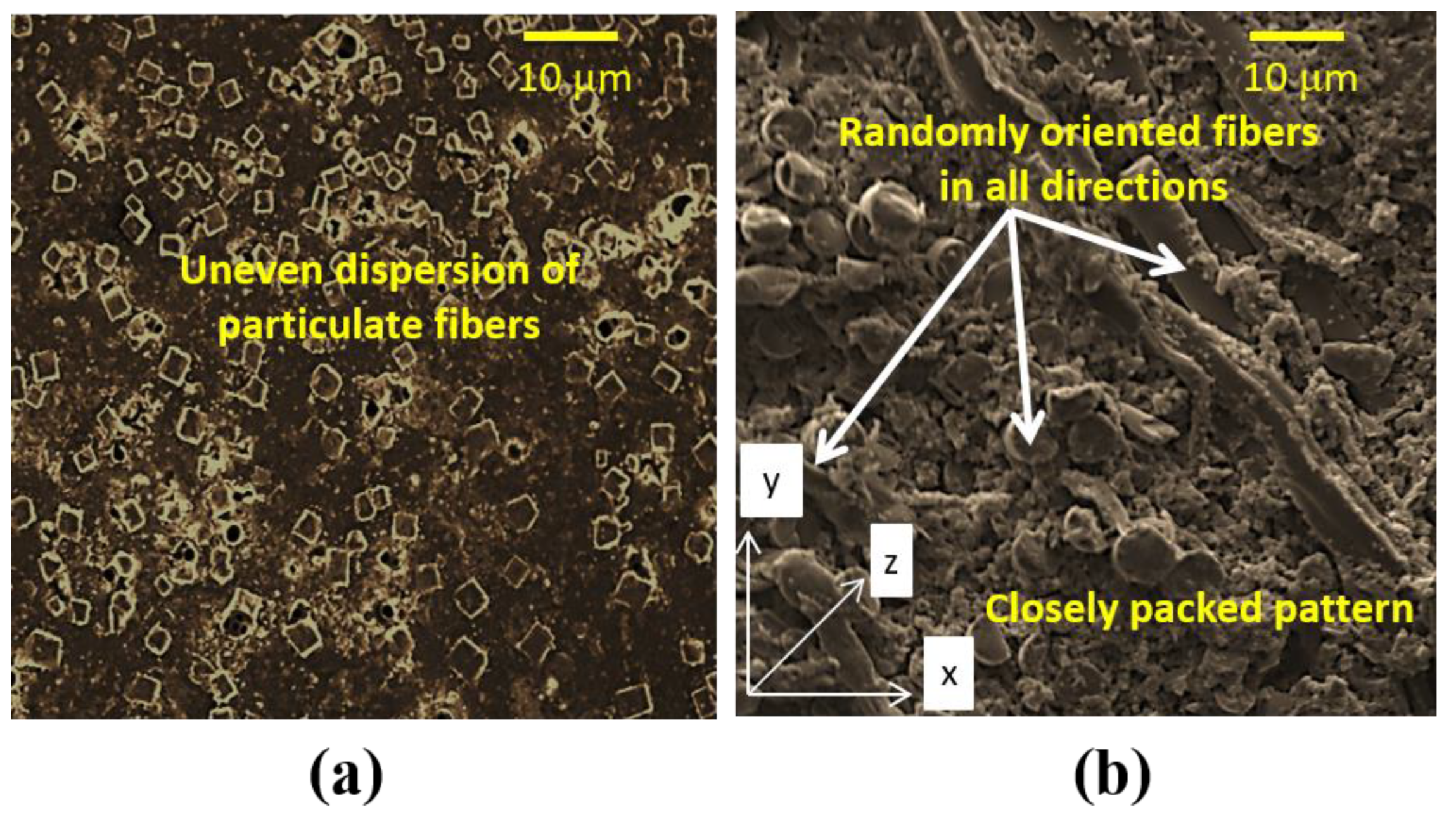
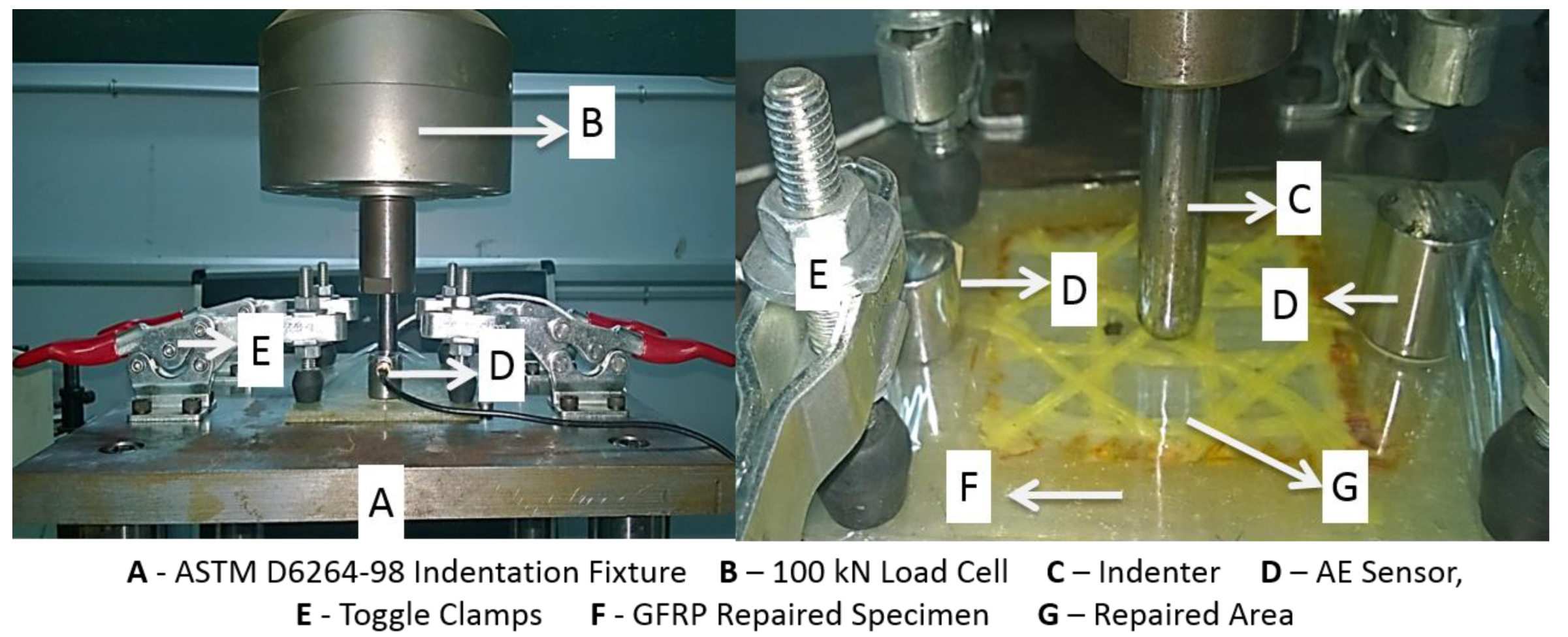
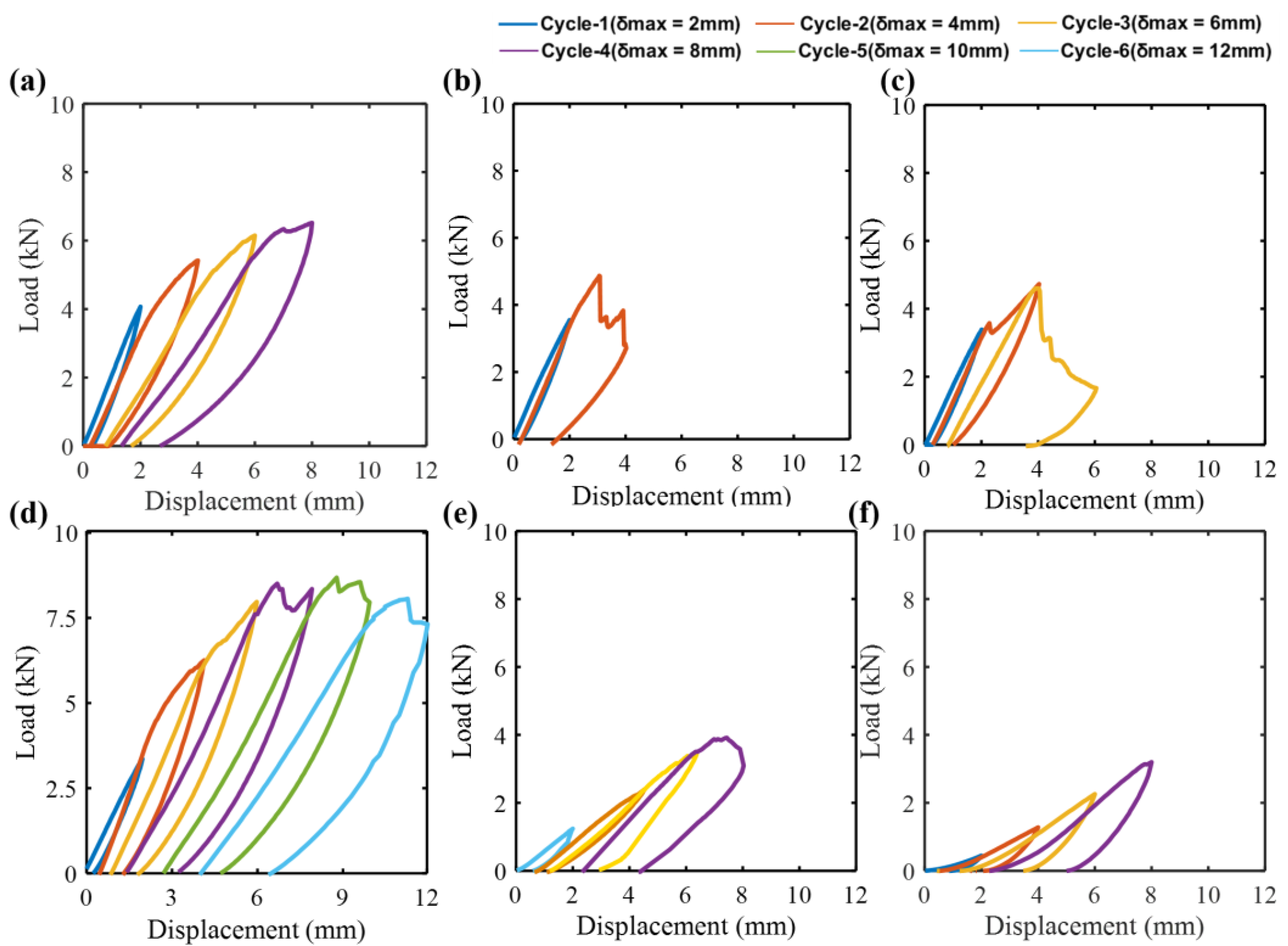
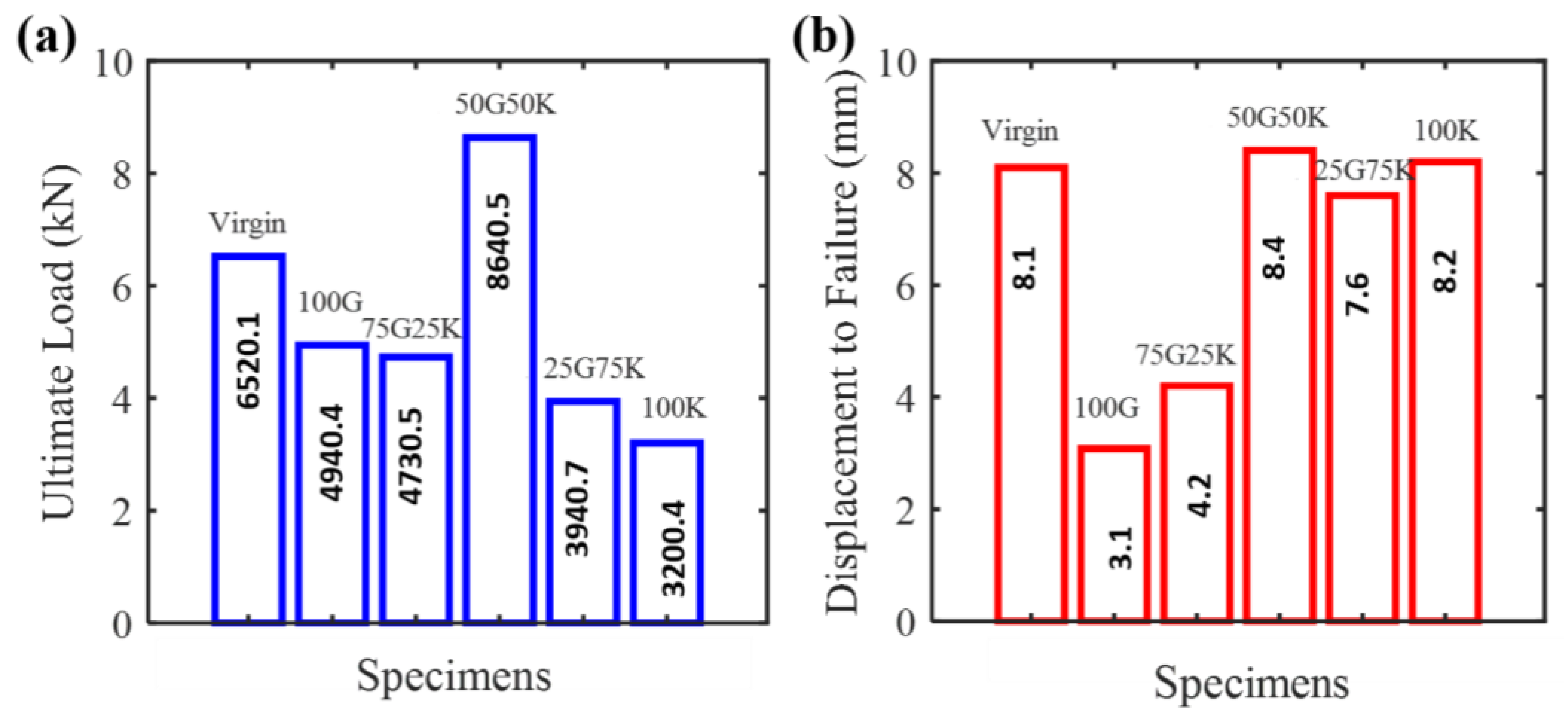
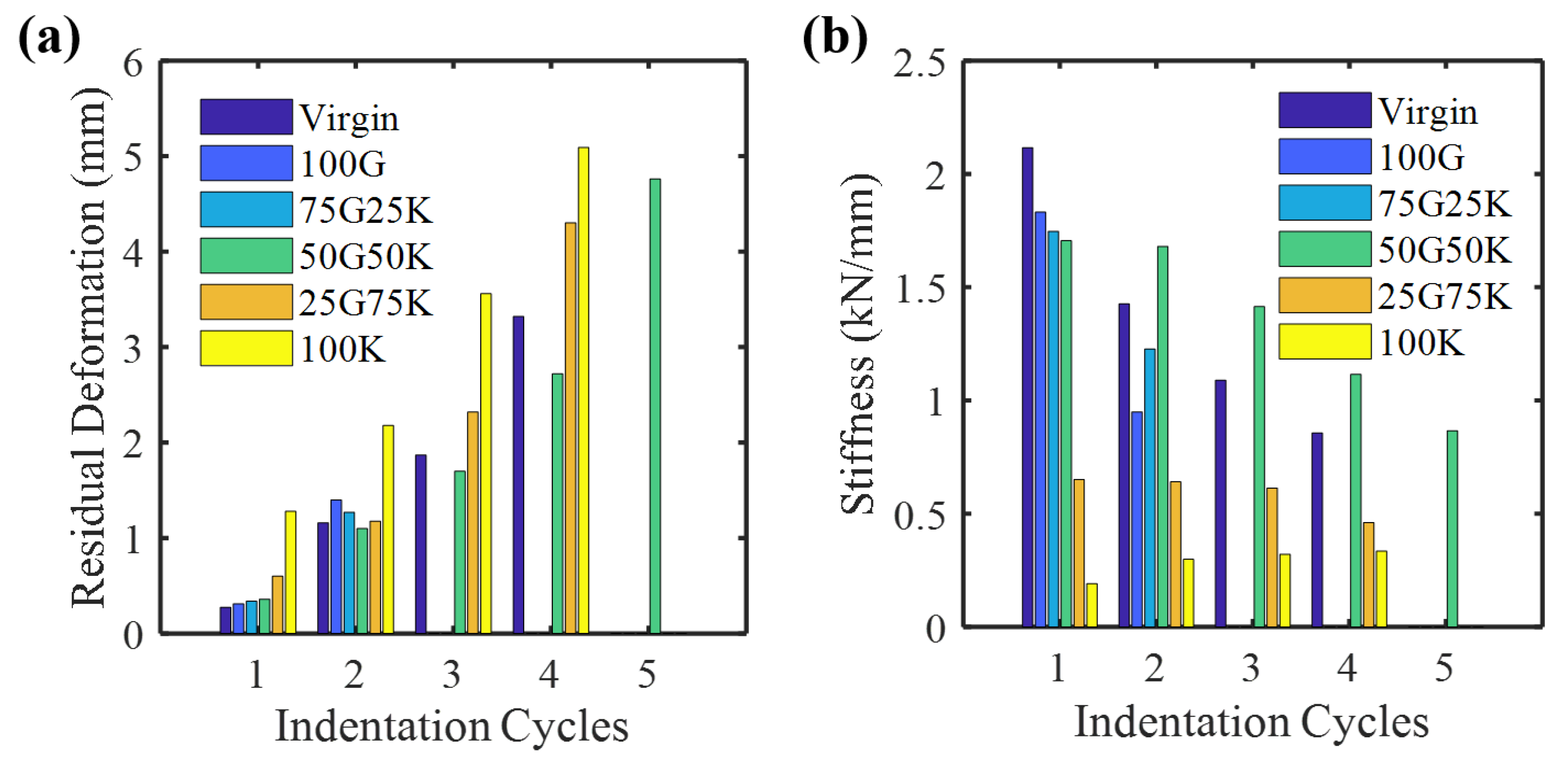
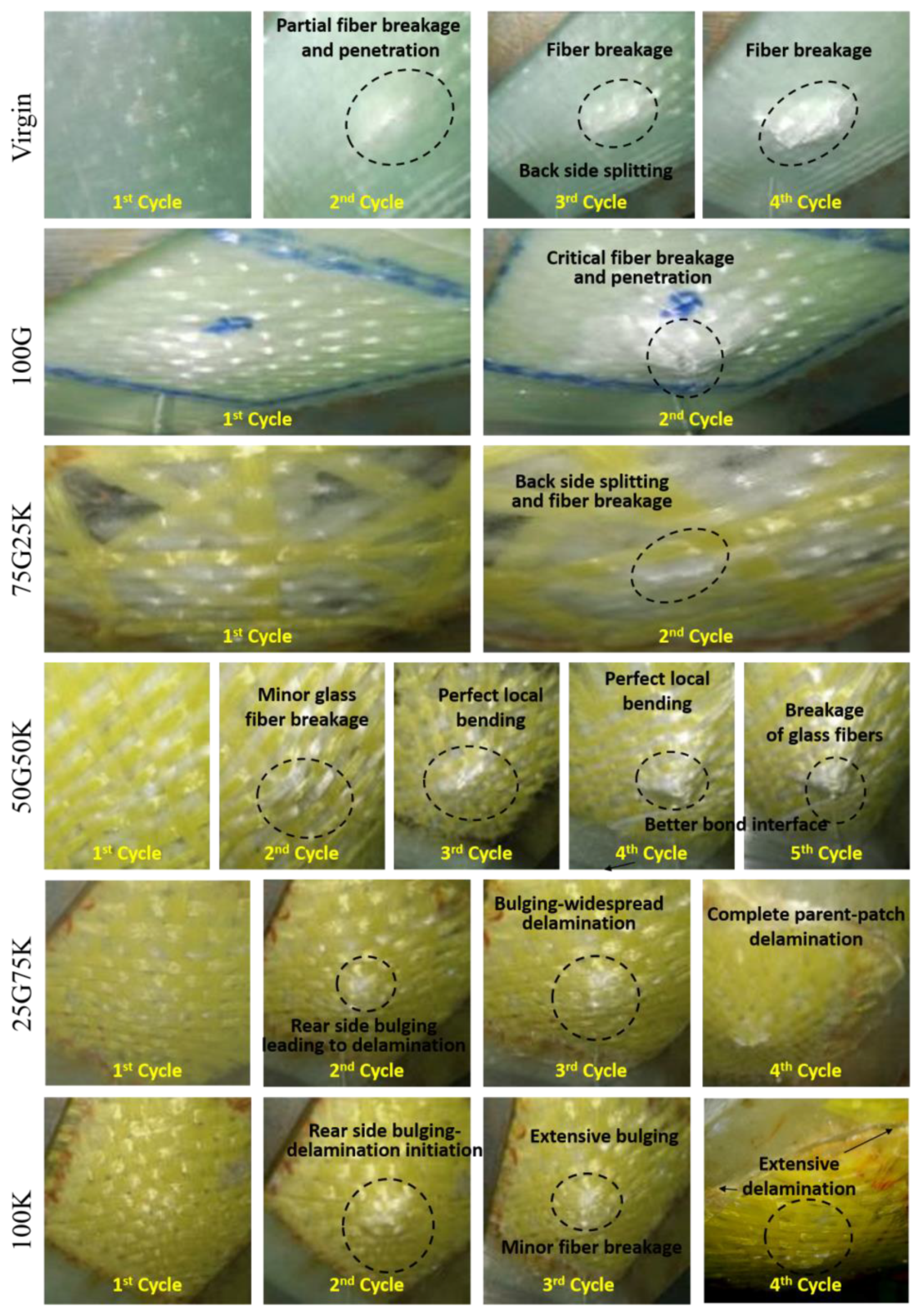
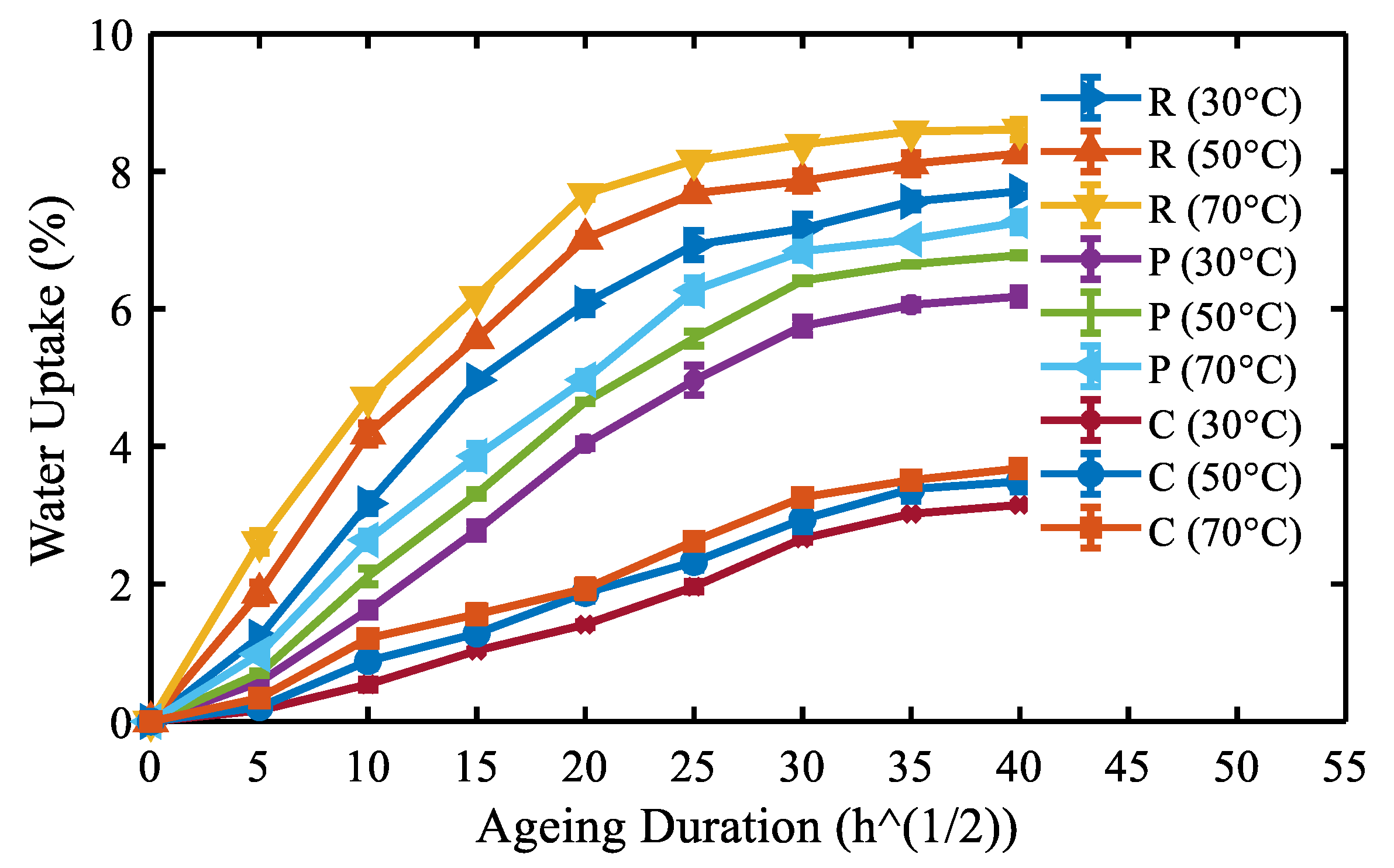
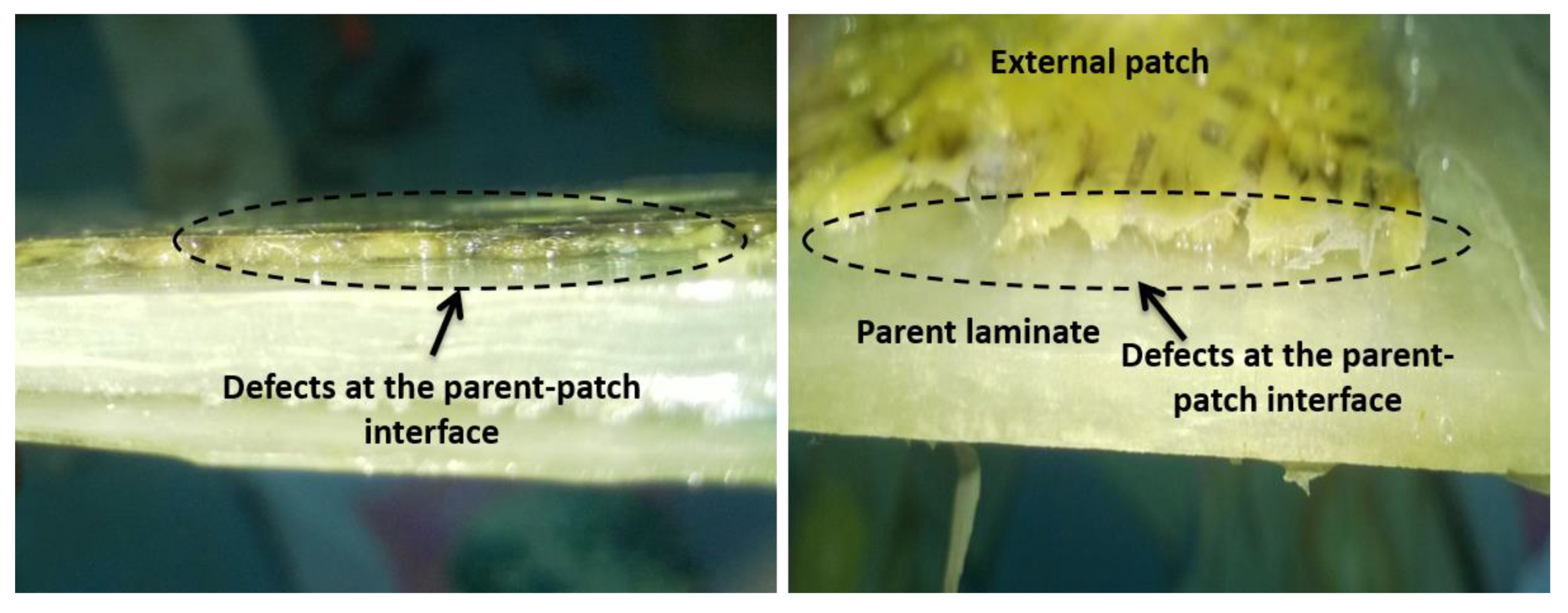
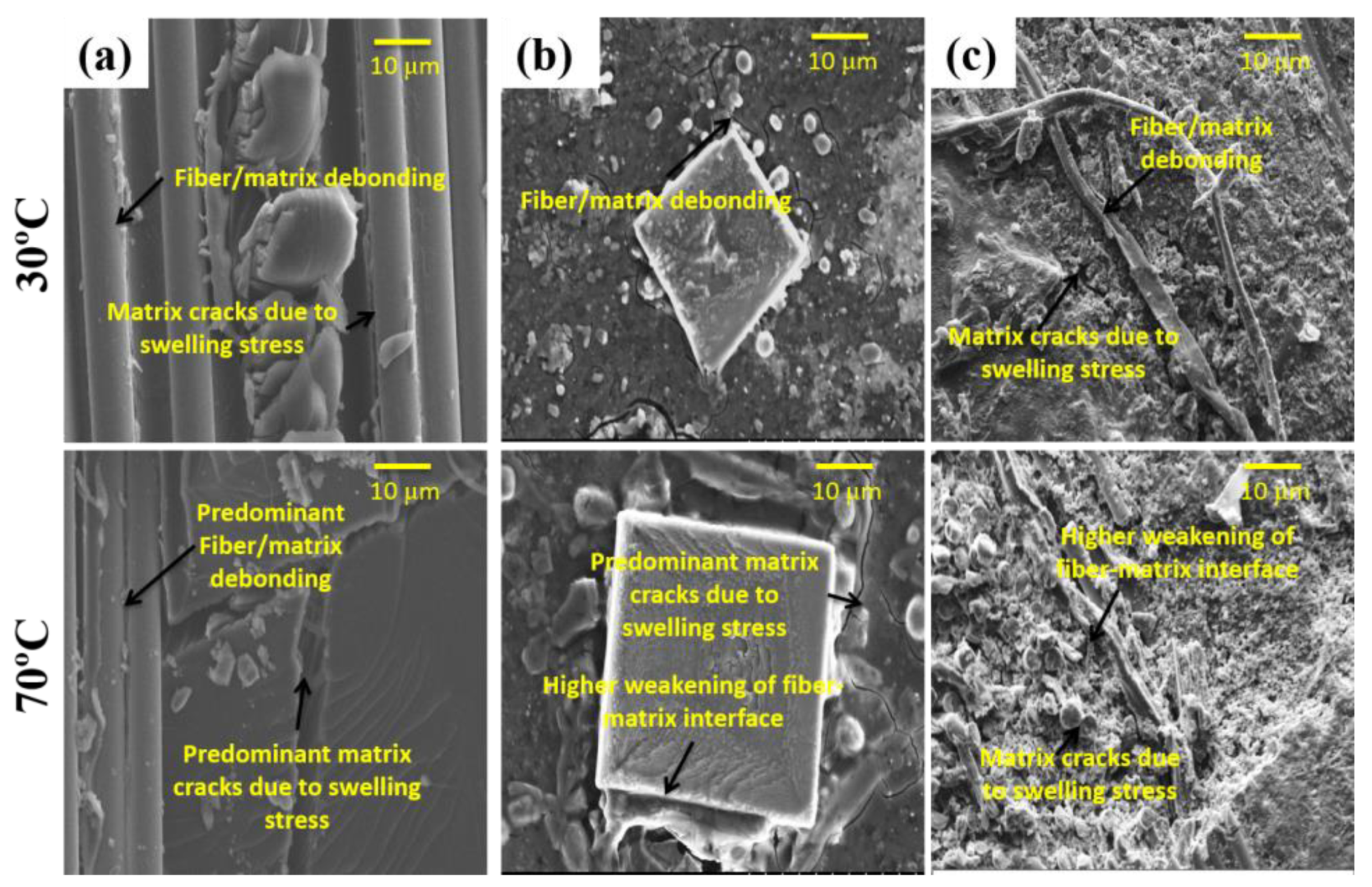
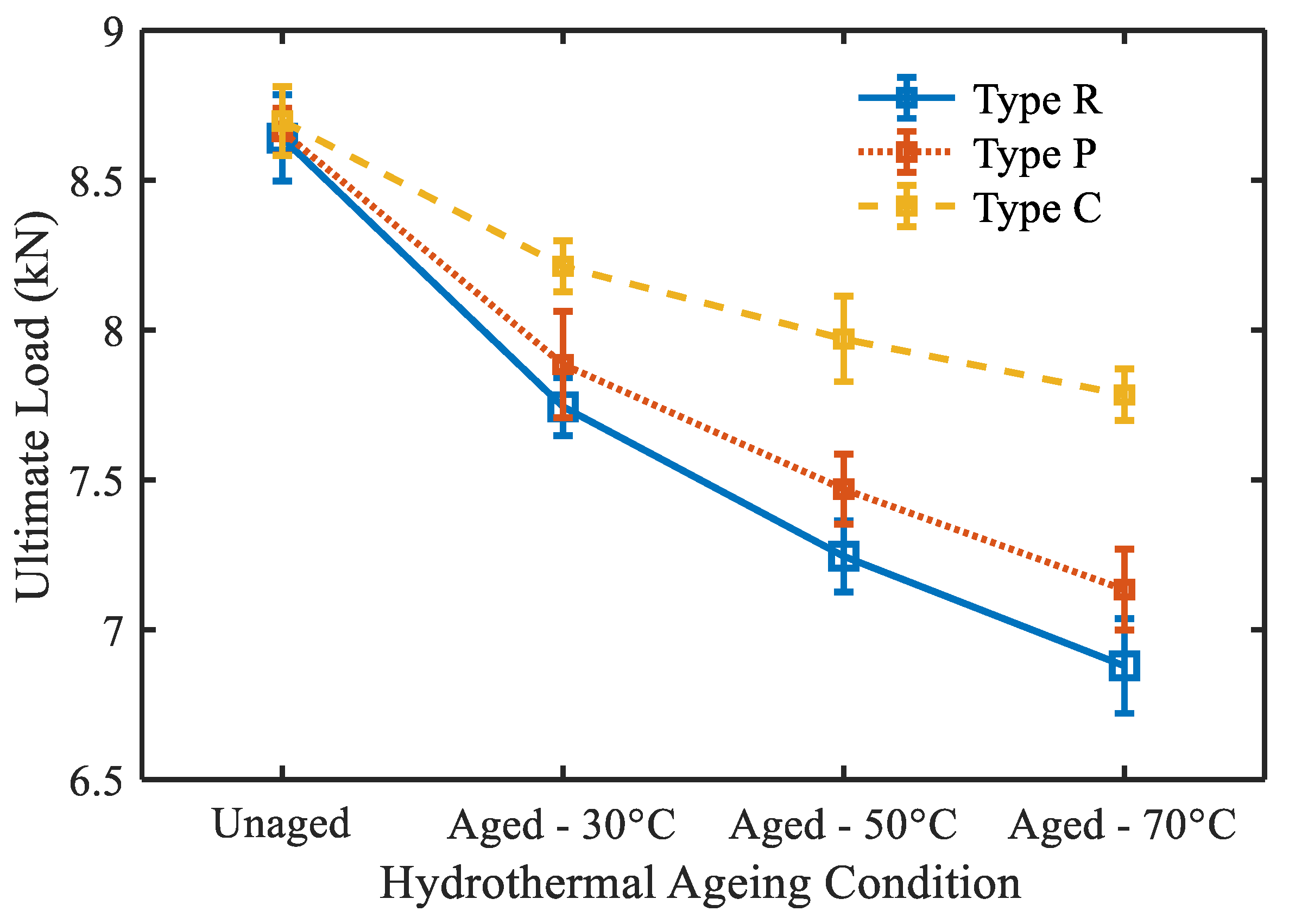
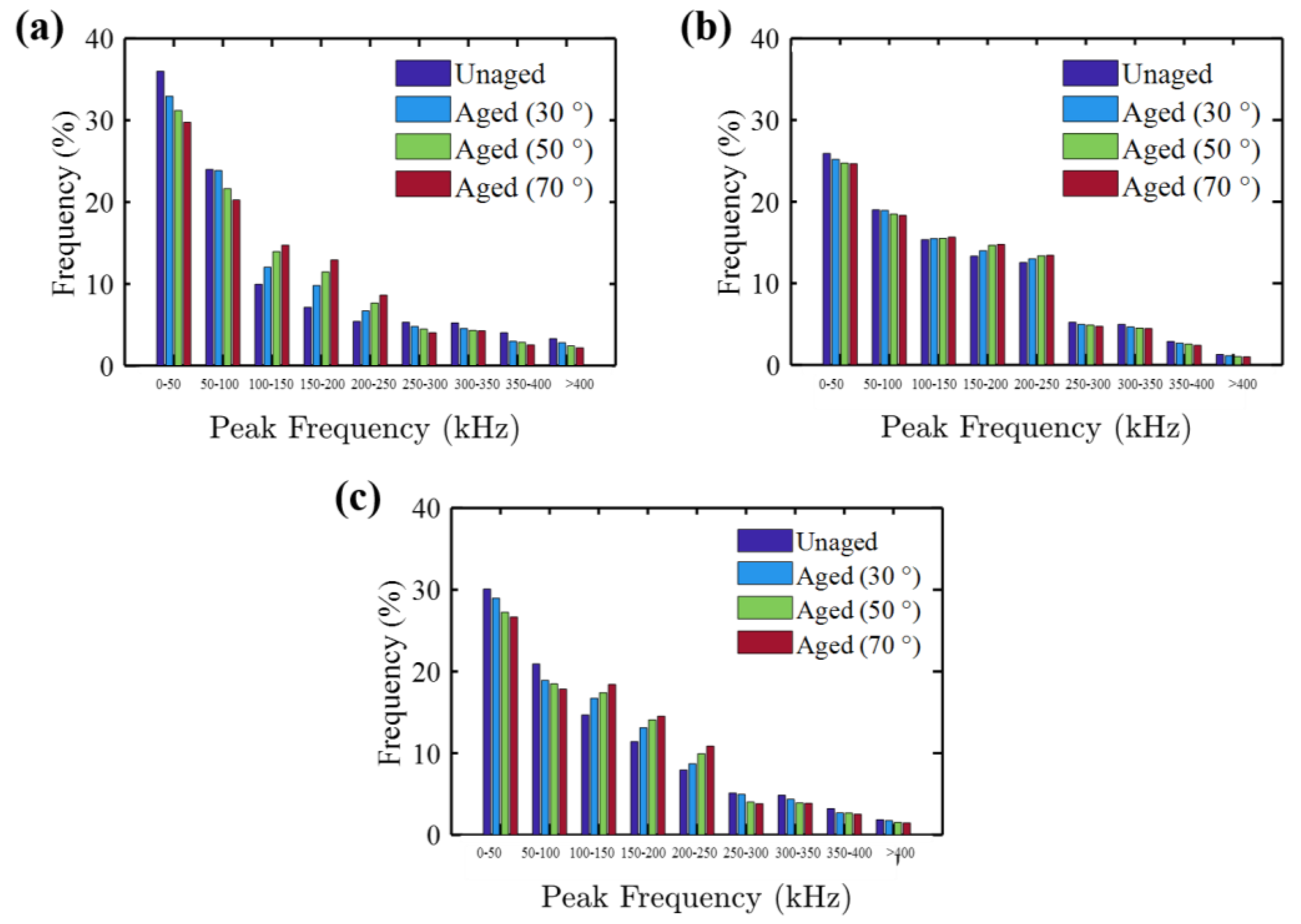
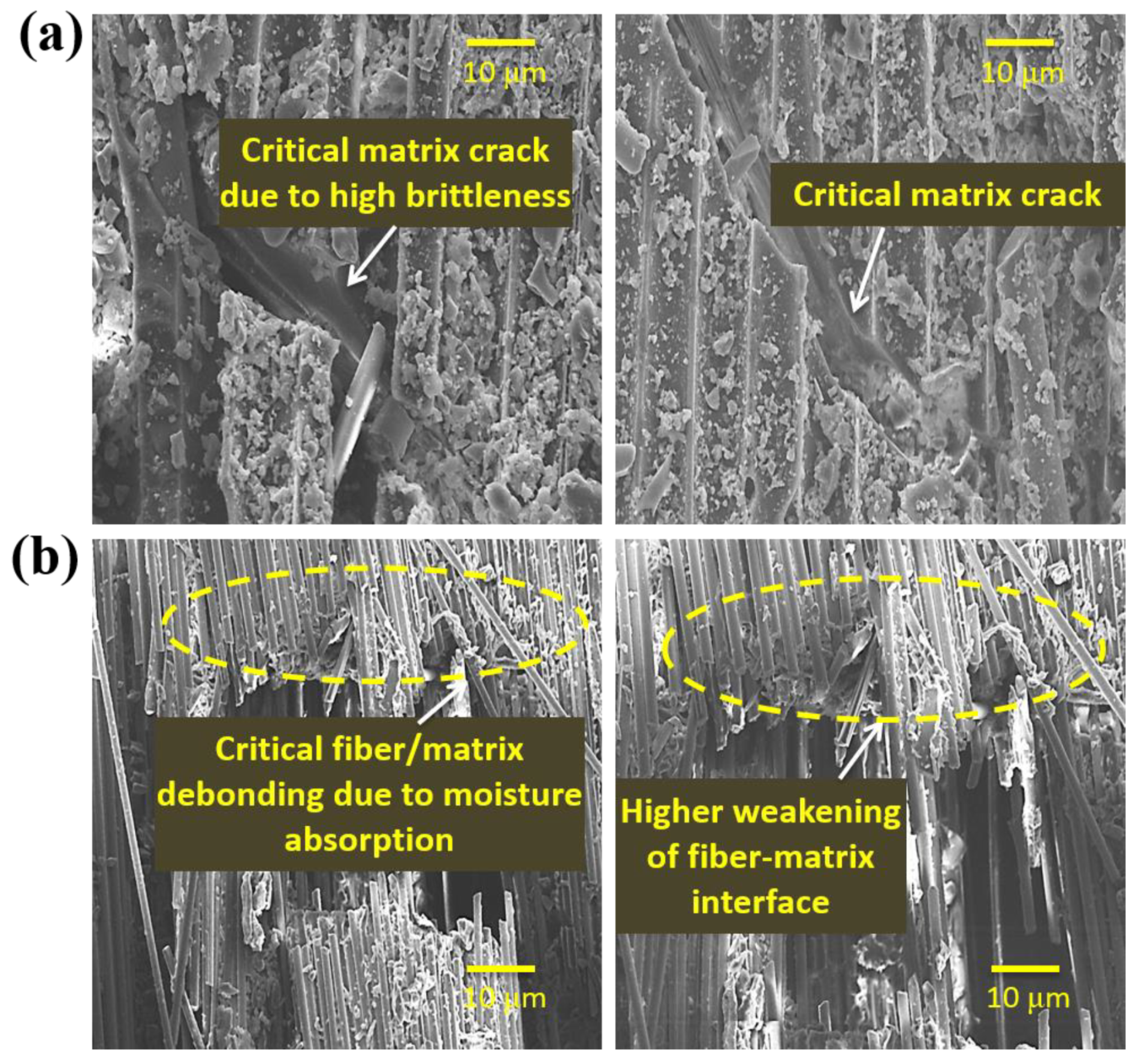
| Specimen | Stacking Sequence | Specimen Code |
|---|---|---|
| Un-modified 50G50K specimens | R | Type R |
| 50G50K specimens modified with particulate fibers | P/R/P | Type P |
| 50G50K specimens modified with chopped fibers | C/R/C | Type C |
| Specimen | Aging Condition (°C) | Equilibrium Moisture Content (%) | k | Diffusion Coefficient (×10−11 m2/s) |
|---|---|---|---|---|
| Type R | 30 | 7.71 | 0.996 | 2.7441 |
| 50 | 8.26 | 1.205 | 2.8901 | |
| 70 | 8.75 | 1.280 | 2.9964 | |
| Type P | 30 | 6.18 | 0.860 | 2.5422 |
| 50 | 6.68 | 0.9905 | 2.6491 | |
| 70 | 7.16 | 1.057 | 2.7291 | |
| Type C | 30 | 3.15 | 0.439 | 2.2774 |
| 50 | 3.49 | 0.477 | 2.3145 | |
| 70 | 3.68 | 0.489 | 2.3376 |
| Specimen | Aging Condition | Ultimate Load (N) | Stiffness (MPa) |
|---|---|---|---|
| Type R | Unaged | 8640.78 | 1706.50 |
| 30 °C | 7743.69 | 1578.45 | |
| 50 °C | 7244.53 | 1507.16 | |
| 70 °C | 6878.70 | 1454.88 | |
| Type P | Unaged | 8662.28 | 1718.77 |
| 30 °C | 7884.85 | 1598.14 | |
| 50 °C | 7468.31 | 1566.58 | |
| 70 °C | 7133.10 | 1531.37 | |
| Type C | Unaged | 8697.10 | 1739.14 |
| 30 °C | 8212.14 | 1644.99 | |
| 50 °C | 7969.71 | 1621.29 | |
| 70 °C | 7783.52 | 1594.21 |
© 2020 by the authors. Licensee MDPI, Basel, Switzerland. This article is an open access article distributed under the terms and conditions of the Creative Commons Attribution (CC BY) license (http://creativecommons.org/licenses/by/4.0/).
Share and Cite
Andrew, J.J.; Arumugam, V.; Dhakal, H.N. Effect of Intra-Ply Hybrid Patches and Hydrothermal Aging on Local Bending Response of Repaired GFRP Composite Laminates. Molecules 2020, 25, 2325. https://doi.org/10.3390/molecules25102325
Andrew JJ, Arumugam V, Dhakal HN. Effect of Intra-Ply Hybrid Patches and Hydrothermal Aging on Local Bending Response of Repaired GFRP Composite Laminates. Molecules. 2020; 25(10):2325. https://doi.org/10.3390/molecules25102325
Chicago/Turabian StyleAndrew, J. Jefferson, Vellayaraj Arumugam, and Hom N. Dhakal. 2020. "Effect of Intra-Ply Hybrid Patches and Hydrothermal Aging on Local Bending Response of Repaired GFRP Composite Laminates" Molecules 25, no. 10: 2325. https://doi.org/10.3390/molecules25102325
APA StyleAndrew, J. J., Arumugam, V., & Dhakal, H. N. (2020). Effect of Intra-Ply Hybrid Patches and Hydrothermal Aging on Local Bending Response of Repaired GFRP Composite Laminates. Molecules, 25(10), 2325. https://doi.org/10.3390/molecules25102325







